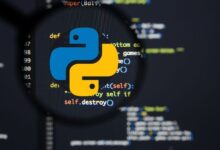
As we delve into the world of coding technologies, we encounter Python – a leading, versatile programming language with a striking emphasis on code readability and expressibility. The essence of Python manifests through its unique syntax, built-in data types, and diverse functions that have established it as a predominant force in numerous domains. This essay explores the intricacies of Python’s underpinnings, enhancing insights into its syntax, and the efficiency and versatility each line of code promises.
Moreover, with an extensive application in data science, Python’s prowess cannot be underestimated. Thus, the spectrum of Python extends beyond the fundamentals to the strategic role it plays in data analysis, visualization, and machine learning. Through a deep dive into Python’s varied data libraries, we will further understand why it has become the leading choice for scientists and analysts. Prepare to be engrossed by the breadth and depth of Python’s potential in data science as tested and proven in tangible, real-world scenarios.
Python Fundamentals
The Python language, credited to Guido van Rossum in 1991, is one with distinctive features that unequivocally set it apart from others of its kind. Its code syntax, utilizing fewer lines of code, earns it an unequivocal reputation as a high-level, interpreted, and general-purpose language. This renowned ease of readability conveys Python’s uncompromising emphasis on simplicity and transparency.
Python’s versatile nature finds its home in multiple domains: web development, artificial intelligence, data analytics, software development, scientific computing, and more. This wide-ranging applicability sings of Python’s strength as a language fostering a diversity of solutions and opening a multitude of doors into such a compelling digital era.
Under Python’s hood, a dynamic type system and memory management reside, contributing substantially to its overall uniqueness. The dynamic typing in Python, a fundamental yet salient feature, implies that the type of data encapsulated in a variable is checked at runtime, offering incredible flexibility compared to statically-typed languages like C++ or Java, where type checking takes place at compile time.
Python’s automatic memory management is yet another testament to its undoubted beauty. This feature leads to gratifyingly short code as it clears away occupied memory that is no longer in use, allowing the programmer to focus more decidedly on the actual problem-solving at hand, rather than the management of computer memory. The two-pronged approach of Python’s memory management system, namely reference counting and garbage collection, sets up a rigorous defense against memory leaks, thus enhancing program efficiency.
Python’s object-oriented nature is a fundamental cornerstone in AI and data science domains. By allowing the creation of objects, modules, and namespaces, Python delves into a neat and clean coding environment that facilitates sustainable and modular programming. Combined with the immersive library ecosystem, this feature underlines Python’s status as a high-level abstract language and pulls it to the forefront of AI and data science research.
The incorporation of Python’s ‘batteries included’ philosophy, embracing a rich standard library, certainly makes it a stand-out programming language. This plethora of built-in modules immediately available post-installation is one of Python’s defining features. This inherent robust framework of tools cater to an array of computational needs without necessitating third-party libraries, thus reducing dependency.
Comprehending these key fundamental attributes highlights Python’s noteworthy code efficiency, readability, and wide domain applicability. These qualities have indubitably contributed to Python’s growing popularity among both seasoned and novice developers.
In conclusion, one can see Python as a coding language that embodies both intuitiveness and sophistication; a language where brevity and functionality handsomely intertwine, underscoring Python’s distinctive flavor in the spectrum of programming languages.

Application of Python in Data Science
Initiating the dialogue on Python’s dominance in data science, it is important to recognize one of the imperative factors: the availability of comprehensive data science libraries. Python has augmented its utility for data science with an exhaustive trove of libraries, specifically fashioned to tackle diverse data science challenges. Libraries such as NumPy for numerical computations, Pandas for data manipulation, Scikit-Learn for machine learning, Matplotlib for data visualization, and TensorFlow for deep learning, just to name a few. These well-maintained, fully documented libraries result in an efficient toolset for the data scientist, underscoring Python’s influence in the domain.
Another critical factor for Python’s imperial command over data science is its compatibility with big data. The advent of big data has plunged industries into an epoch where the understanding and interpretation of huge datasets is vital. Python’s compatibility with Hadoop, the most widely used big data platform, endows it with a decisive advantage. Through libraries like PyDoop and Dask, Python seamlessly processes and analyzes large-scale data, making it an imperative tool in the arsenal of data scientists dealing with voluminous data.
Taking note of the aforementioned points, we cannot undermine the significance of Python’s community support in its dominance over data science. The informative Python developer community offers immense support through online forums, tutorials, and solution guides. The data science community regularly updates and optimizes Python’s data science libraries, ensuring they remain pertinent to current trends. The availability of comprehensive solutions for coding issues or algorithmic puzzles amplifies Python’s appeal as the language of choice for data science.
Further, Python’s platform-agnostic nature enhances its adaptability and broadens its use. The flexibility to operate across multiple platforms like Windows, MacOS, Linux, Unix, among others, without changing its core behavior or functionality, provides Python with an adaptive edge. This platform independence empowers developers and data scientists to work across diverse environments without worrying about coding discrepancies or compatibility issues.
Crucially, Python’s core philosophy of readability and simplicity does not falter when it comes to complex data science tasks. Data science often involves intricate algorithms and multifaceted computations. Python’s simple syntax and code readability allow for efficient implementation of these complicated algorithms in a clear, logical, and concise manner.
Arguably, Python’s interactive programming IDE (Integrated Development Environment) further solidifies its foothold in the realm of data science. IDEs like Jupyter and Spyder facilitate convenient code drafting, testing, and visualization. These IDEs powerfully combine code execution, textual explanation, and visualization into a single, user-friendly interface, streamlining data analysis, and experimental tasks.
In conclusion, Python commandeers the domain of data science not merely because of its technical aptness, but also due to its community support, compatibility, versatility, and adaptability. Its stronghold across diverse aspects of data science, combined with robust libraries and data-centric features, elucidates Python’s irresistible allure in the field of data science.

Advanced Python techniques
Expanding on the realm of Python programming, it is essential to delve into advanced optimization techniques that significantly augment Python’s power and efficiency. These tactics range from simple code reconfigurations to the implementation of advanced algorithms, all aimed at enhancing the operational speed and reducing memory consumption of Python programs.
The Strategized Use of Built-In Functions and Libraries
Python, noted for its richness of built-in functions and extensive standard libraries, offers ample opportunities to leverage these inherent functionalities for performance optimization. Built-in functions such as range(), map(), and filter() provide substantial time and space efficiency benefits when employed in lieu of traditional loop construction. Additionally, Python’s standard library is a reservoir of modules like itertools and functools that carry sophisticated tools to facilitate productive and efficient programming.
Python’s Just-In-Time Compilation
Just-In-Time (JIT) compilation signifies an advanced technique that bolsters Python’s efficiency. By compiling parts of the program at runtime, Python shortens the usual gap observed between interpretation and execution in standard interpreters, leading to better runtime performance. Libraries such as PyPy and Numba leverage the JIT compilation technique to accelerate Python computations, rendering them suitable for high-performance tasks.
Concurrent and Parallel Programming
Python’s threading and multiprocessing modules allow for concurrent and parallel execution of tasks, thereby optimizing CPU utilization, and enhancing program efficiency. While the threading module enables concurrent execution through multiple threads of a single process, the multiprocessing module introduces the power of parallelism, allowing different processes to run simultaneously on different processors.
Optimization through Vectorization
Vectorization involves the replacement of explicit loops with array expressions. The algorithms implemented through libraries like NumPy and Pandas are vectors based, meaning they handle operations on entire arrays, enhancing computational speed and memory use.
PyO3 for Python-Rust Binding
A novel advancement in Python optimization is the use of foreign languages that are naturally more powerful and efficient. PyO3 is a remarkable tool that allows for binding Python with Rust, a language renowned for its safety, speed, and concurrency. By compiling Python extensions in Rust, programmers can experience beefed-up operation speed and reduced memory usage.
While these advanced optimization techniques significantly enhance Python’s efficiency and power, the essence of the performance optimization process lies in the prudent diagnosis of bottlenecks and the judicious selection of techniques aligning with specific task requirements. It must be well understood that Python’s USP is its ease-of-use and readability. The objective while optimizing should always prioritize these fundamental strengths of Python over arbitrary efficiency enhancements.

Delving into the finer aspects, we then transitioned into advanced Python techniques, shedding light on constructs and patterns such as decorators, list comprehensions, generators, and context managers. By adeptly demonstrating the practicality of these constructs, we’ve seen how they contribute to writing not just efficient, but remarkably expressive and high-performing Python code. The advanced depth of Python’s flexibility and expressibility radiates through these topics, establishing Python as an extensively robust programming language that enables clean and maintainable code.
As we navigate the dizzying world of Python, from its fundamentals to its advanced implementation, its role in data science, and the power of its many libraries, we appreciate the extensive capabilities this programming language presents to its users. Reflecting on the exploration of Python we’ve embarked upon, we realize the language’s prowess and how it encourages us to constantly innovate and learn. Python, in its simplicity and complexity, serves as a paradigm of the possibilities it brings forth for enthusiasts, hobbyists, and professionals alike.
Writio: The ultimate content writer – quality articles, effortless publishing. This article was crafted by Writio.



